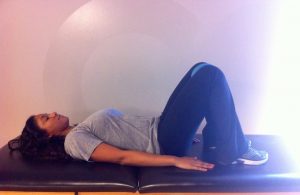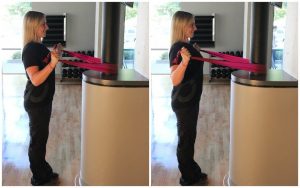
Q. I’m pregnant and want to maintain a healthy level of activity. What are some safe exercises I can do?
First of all, congratulations! Whether this is your first child or your seventh (wow!), there are so many bonuses to maintaining a healthy level of activity during pregnancy. Exercising is great way to prevent some of the common pain that can accompany pregnancy, get your body ready for birth, and even speed up your recovery time after delivery.
What does a good workout during pregnancy look like? Stick to what you’ve been doing. You don’t want to push your body into activities it isn’t accustomed to doing. In other words, if you’re a runner, continue to run (keeping pace and distance easy to moderate). If you’re not a runner, this is not the time to start training for your first marathon. Walking, swimming, dance classes, and working out on an elliptical machine are also great forms of cardio.
Exercising at least 30 minutes a day is a good goal. But cardio isn’t the only form of fitness to focus on. I like to focus on a few key areas when giving exercises to pregnant women: the core, glutes and legs, and shoulders and neck.
CORE
There’s a reason why you don’t see pregnant women with six packs. During pregnancy the rectus abdominis become stretched and stop working as efficiently. (In some cases, the rectus abdominis can even separate.) This means other core muscles—your transverse abdominis, diaphragm, pelvic floor muscles, and back muscles—have to pick up the slack. One of the most important things you can do during your pregnancy is to strengthen those core muscles.
One exercise that can help strengthen your core, specifically the pelvic floor muscles, is a kegel ball squeeze. These are typically done on your back; however after the first trimester the move should be modified, and performed while seated at a 45-degree incline.
Move #1: Kegel Ball Squeeze
- Lie on your back (or sit at a 45-degree incline) with your knees bent and feet flat on the ground. Place a small medicine ball in between your knees. (If you don’t have a medicine ball, you can use a pillow.)
- Keep your back flat throughout the entire exercise.
- Contract your pelvic floor muscles (a.k.a. kegel) and squeeze the ball, holding for five seconds. (Not sure how to kegel? Pretend that you have to stop the flow of urine.)
- Do two to three sets of 15 repetitions.
GLUTES AND LEGS
As your belly grows, your stretched abdominal muscles will no longer be as capable of absorbing force and stabilizing your body, so your body will be depending more on your legs (likely, your quadriceps) and glutes. Moves that strengthen and elongate these muscles are essential, and adductor (inner thigh) squats are an excellent choice.
Move #2: Adductor Squats
- Place your feet shoulder width apart, with your toes pointed out at 45-degree angles. (Be sure to turn out from your hips, not your knees.) Weight should be placed back through your heels.
- Begin to squat down by bringing your hips back, as though you are about to sit down in a chair that is too far behind you. Try to move your knees out behind you as you squat.
- Sink down as low as you can, then push back up through your heels.
- If you’re having trouble keeping your balance, use a chair for extra support.
- Do two to three sets of 15 repetitions.
SHOULDERS AND NECK
Last, but not least, it’s important to strengthen your postural muscles. As your abdomen and chest expand, there is a shift in your center of gravity that forces the spine to adjust. Your shoulders round forward and your lower back curves to compensate for the additional weight, making it extra important to strengthen your back to compensate for these issues. Moves with a resistance band, such as A’s and W’s, can strengthen the muscles in your upper and middle back and help combat that anterior (forward) pull.
Move #3: Standing W’s with Resistance Band
- Loop a resistance band around a pole, tree, or other sturdy object.
- Stand tall with your feet shoulder width apart, knees relaxed, abs contracted, and arms bent at the elbows forming a “W,” with thumbs and fingers up.
- Grab the resistance band while keeping your palms forward. Squeeze shoulder blades together (pinch them down and back), bring wrists straight back with elbows pointing toward the ground. Hold for three seconds.
- Repeat for two-three sets of 15 reps.
Exercising during pregnancy has so many great benefits, but always make sure to check in with your doctor before trying something new or if there are any moves or exercises you feel uncertain about.
Got a question for David? Ask in the comments below and you might see the answer appear here on the blog in a few weeks!

